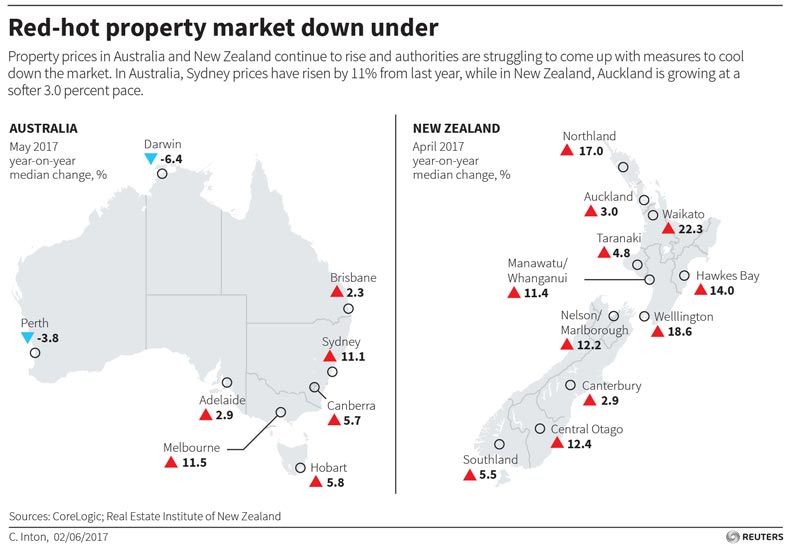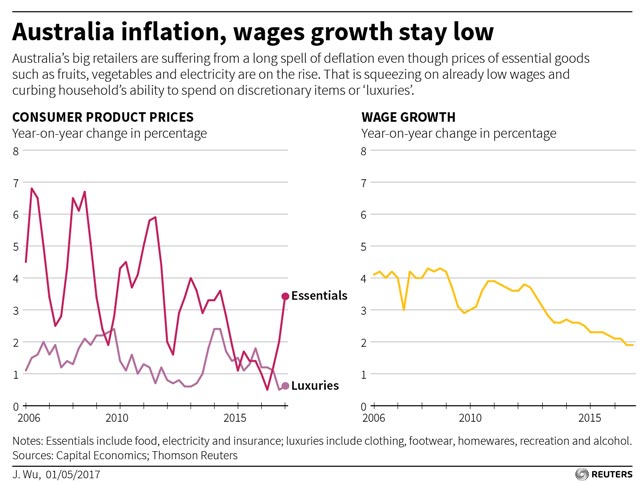Australia’s economy may have achieved a remarkable winning streak, avoiding a recession for 25 years, but there are now clear signs that the consumers who have driven much of the growth are running out of puff.
With cash interest rates at a record low and house prices near record highs, the nation’s household debt-to-income ratio has climbed to an all-time peak of 189 percent, according to the Reserve Bank of Australia (RBA).
That means there are an increasing number of people who have little cash for discretionary spending – on everything from cars to electrical appliances and new clothes – as their pay packets get consumed by large mortgages and high rental payments in the country’s red-hot property market.
And it’s not as if a sudden plunge in home prices would help – it might well expose and exacerbate the problem, at least in the short run, squeezing many who have bought into the frothy market with high mortgage repayments and little equity in their homes.
“We are seeing a considerable spike in stress even in more affluent households. Large mortgages, big commitments but no income growth,” said Digital Finance Analytics (DFA) Principal Martin North. “Stressed households are less likely to spend at the shops, which acts as a drag anchor on future growth.”
North estimates a record 52,000 households risk default in the next 12 months and that 23.4 percent of Australian families are under mortgage stress, meaning their income does not cover ongoing costs. That compares with about 19 percent a year ago.
“People are up to their ears in mortgages,” said Brad Smith, a car sales consultant at MotorPoint Sydney which has seen a stark slowdown in sales in the past six months. “They are all on a budget. Everyone’s got all their money in houses, that’s how it is.”
Australians are also facing a cash crunch because price inflation in essential items such as food, electricity and insurance is accelerating at a 3.4 percent annual rate at a time when Australian wages are rising at their slowest pace on record, just 1.9 percent in the year to March.
Meanwhile, growth in retail sales, personal loans and luxury car sales are all at multi-year lows, suggesting the household sector – nearly 60 percent of Australia’s A$1.7 trillion ($1.3 trillion) economy – is under severe strain.
A CONSUMPTION PROBLEM
Australia’s love affair with property is worrying the RBA which has repeatedly warned against the danger of excessive real estate borrowing and the impact on spending elsewhere in the economy.
The central bank is reluctant to raise interest rates to cool the property market as it is concerned that would hit domestic demand at a time when real wages growth has turned negative. Besides, borrowing by businesses is growing at the slowest rate in three years.
Still, signs of a spending pullback is prompting economists to rethink Australia’s strong growth projections.
Only last month, the RBA upgraded its gross domestic product (GDP) forecast by 25 basis points to an annual 2.75-3.75 percent by the middle of next year from 2.50-3.50 percent it projected in February.
RBA’s confidence emanates from a levelling off in mining investment after years of steep falls, a rebound in the price of iron ore and coal prices – Australia is a major exporter of both – from 2015 lows, and the home building boom.
However, many believe the central bank’s forecast might prove too optimistic.
Both Morgan Stanley and National Australia Bank believe the economy might have slammed into reverse in the March quarter, after rising 1.1 percent in the December quarter. First-quarter GDP data is due on June 7.
“As the housing market slows, we see consumption growth as a major risk amid record-low wages growth and ongoing headwinds to discretionary cash flows,” Morgan Stanley economist Daniel Blake said.
RETAILING PAIN
Weak consumer spending is proving a huge drag on retailers’ performance, with shares in furniture and appliance chain Harvey Norman and electronics shop JB Hi-Fi both trading near one-year lows.
Retail sales have hardly grown in the past few months. Even online sales have slowed, with all major categories including homeware, games and toys, daily deals and takeaway food shrinking in April, according to the NAB Online Retail Sales Index.
Car sales have flattened this year after solid growth in 2016 while sales of luxury cars and sports utility vehicles are at a four-year low.
For consumers such as Sydney resident Marie-Aimee Guillermin, there’s little ‘play money’ left after stepping into Sydney’s housing market with a A$1.4 million 3-bedroom house last month.
“We thought once we had the house we could take our foot off the brake a little bit but now that we have it I feel even less certain in terms of stability and financial security,” she told Reuters.
“So whether we’ll end up spending a bit more on clothes and restaurants and going out and what have you I don’t see that happening.” ($1 = 1.3377 Australian dollars)
(Reporting by Swati Pandey; Editing by Jonathan Barrett and Martin Howell)



2 thoughts on “Australians Curb Spending as Household Debt Balloons”